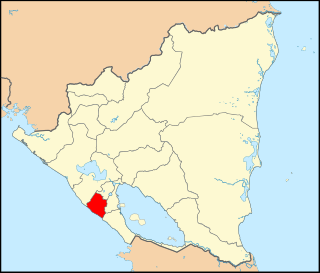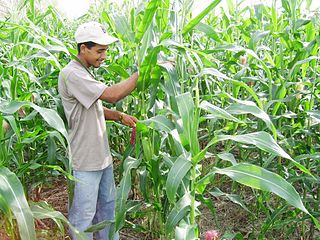
Carazo is a department in Nicaragua. It covers an area of 1,081 km2 and has a population of 198,395. The capital is Jinotepe.
Jinotega is the capital city of the Department of Jinotega in north-central Nicaragua.

Matagalpa is a city in Nicaragua which is the capital of the department of Matagalpa. The city has a population of 111,258, while the population of the department is 600,057. Matagalpa is Nicaragua's seventh largest city, the largest in the country's interior, and one of the most commercially active outside of Managua. Matagalpa is the 4th most important city in Nicaragua and is known as the "Pearl of the North" and "Land of Eternal Spring."

Tipitapa is a city and municipality in the Managua department of western Nicaragua. The area is located between Lake Managua and Lake Nicaragua.

Nicaragua's economic history has shifted from concentration in gold, beef, and coffee to a mixed economy under the Sandinista government to an International Monetary Fund policy attempt in 1990.
Nicaragua produces coffee, cotton, bananas, sugar and beef cattle.
Agriculture continued to be the mainstay of the economy of Haiti in the late 1980s; it employed approximately 66 percent of the labor force and accounted for about 35 percent of GDP and for 24 percent of exports in 1987. The role of agriculture in the economy has declined severely since the 1950s, when the sector employed 80 percent of the labor force, represented 50 percent of GDP, and contributed 90 percent of exports. Many factors have contributed to this decline. Some of the major ones included the continuing fragmentation of landholdings, low levels of agricultural technology, migration out of rural areas, insecure land tenure, a lack of capital investment, high commodity taxes, the low productivity of undernourished animals, plant diseases, and inadequate infrastructure. Neither the government nor the private sector invested much in rural ventures; in FY 1989 only 5 percent of the national budget went to the Ministry of Agriculture, Natural Resources, and Rural Development. As Haiti entered the 1990s, however, the main challenge to agriculture was not economic, but ecological. Extreme deforestation, soil erosion, droughts, flooding, and the ravages of other natural disasters had all led to a critical environmental situation.

Benin is predominantly a rural society, and agriculture in Benin supports more than 70% of the population. Agriculture contributes around 35% of the country's gross domestic product (GDP) and 80% of export income. While the Government of Benin (GOB) aims to diversify its agricultural production, Benin remains underdeveloped, and its economy is underpinned by subsistence agriculture. Approximately 93% of total agricultural production goes into food production. The proportion of the population living in poverty is about 35.2%, with more rural households in poverty (38.4%) than urban households (29.8%). 36% of households depend solely upon agricultural (crop) production for income, and another 30% depend on crop production, livestock, or fishing for income.

The southeast Asian country of Laos, with a landmass of 23.68 million hectares, has at least 5 million hectares of land suitable for cultivation. Seventeen percent of this land area is actually cultivated, less than 4 percent of the total area.

Indonesia was the fourth-largest producer of coffee in the world in 2014. Coffee cultivation in Indonesia began in the late 1600s and early 1700s, in the early Dutch colonial period, and has played an important part in the growth of the country. Indonesia is geographically and climatologically well-suited for coffee plantations, near the equator and with numerous interior mountainous regions on its main islands, creating well-suited microclimates for the growth and production of coffee.

Coffee production in India is dominated in the hill tracts of South Indian states, with Karnataka accounting for 71%, followed by Kerala with 21% and Tamil Nadu. Indian coffee is said to be the finest coffee grown in the shade rather than direct sunlight anywhere in the world. There are about 250,000 coffee growers in the country; 98% of them are small growers. As of 2009, Indian coffee made up just 4.5% of the global production. Almost 80% of Indian coffee is exported; 70% is bound for Germany, Russia, Spain, Belgium, Slovenia, United States, United Kingdom, Japan, Greece, Netherlands and France. Italy accounts for 29% of the exports. Most of the export is shipped through the Suez Canal.

The role of agriculture in the Bolivian economy in the late 1980s expanded as the collapse of the tin industry forced the country to diversify its productive and export base. Agricultural production as a share of GDP was approximately 23 percent in 1987, compared with 30 percent in 1960 and a low of just under 17 percent in 1979. The recession of the 1980s, along with unfavorable weather conditions, particularly droughts and floods, hampered output. Agriculture employed about 46 percent of the country's labor force in 1987. Most production, with the exception of coca, focused on the domestic market and self-sufficiency in food. Agricultural exports accounted for only about 15 percent of total exports in the late 1980s, depending on weather conditions and commodity prices for agricultural goods, hydrocarbons, and minerals.

Agriculture in Panama is an important sector of the Panamanian economy. Major agricultural products include bananas, cocoa beans, coffee, coconuts, timber, beef, chicken, shrimp, corn, potatoes, rice, soybeans, and sugar cane.
Tea is a major cash crop that is grown in Kenya. Kenyan tea has been the leading major foreign exchange earner for the country.
German Nicaraguan is a Nicaraguan having German ancestry, or a German-born naturalized citizen of Nicaragua. This includes Poles due to the Partitions of Poland and Sudeten Germans from present Czech Republic. During the Second World War, after Nicaragua's allies declared war on Germany, German immigrants not naturalized were persecuted and imprisoned. Some were deported to Germany or to concentration camps in other countries. Although Germans have emigrated to Nicaragua since the 19th century, most of the German Nicaraguans still speak both Spanish and German.

Coffee is Uganda's top-earning export crop. In 1989 Uganda's coffee production capacity exceeded its quota of 2.3 million bags, but export volumes were still diminished by economic and security problems, and large amounts of coffee beans were still being smuggled out of Uganda for sale in neighbouring countries. Uganda is one of the few countries in the world with indigenous coffee, with Robusta coffee growing wild around Lake Victoria.
The production of coffee in Paraguay began in the late 19th century. Plantations were known at that time near Asunción and Limpio.
Coffee production in the Dominican Republic is based mainly in the mountain regions of the country, in the highlands which form at least one-half of the area of Hispaniola. Introduced to the country in 1715, the Dominican Republic bean is larger and thicker than Martinique's. The major coffee variety grown in the country is Arabica. Robusta is also grown but only in about 1.3% of the land area; it is consumed locally.

Coffee production in Guadeloupe, an overseas region of France in the Caribbean Sea, has had commercial importance at various times in its history. The island's coffee heritage is being promoted through ecotourism.
Benguet coffee, also known as Benguet arabica, is a single-origin coffee varietal grown in the Cordillera highlands of the northern Philippines since the 19th century. It belongs to the species Coffea arabica, of the Typica variety. It is one of the main crops of farmers in the province of Benguet, which has a climate highly suitable for arabica cultivation. Benguet coffee is listed in the Ark of Taste international catalogue of endangered heritage foods by the Slow Food movement.












